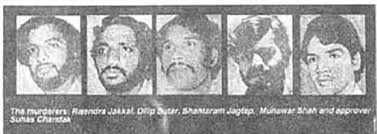
Chapter 1
This is a story of Pune, where four friends went on a killing spree executing 10 persons. Such was the effect of this terror on the minds of people that they stopped venturing out at night. Central Reserve Police force was deployed during the night to patrol the streets of this city.
Pune is a peaceful city in the state of Maharashtra in India. This is an ideal city for livelihood and leading a peaceful life for people of all ages. Currently, Pune is a clean city with a minimal crime rate and is being developed as a smart city.
There are many IT hubs and techies from all over the world work in this city. People of Pune are friendly and very helpful. It is due to the efforts of the government and people; this city has retained its glory.
The period from the beginning of 1976 to the end of 1977, was a bad period for this city. People were scared to move out of their houses during the night. Newspaper reports were full of gruesome murders taking place in the city disturbing its people and peaceful nature.
Ten murders took place within a year making people afraid; such was the effect of these murders that the commissioner of police had to deploy Central Reserve Police force for patrolling its streets during the night.
Abhinav Kala Mahavidyalaya, situated on Tilak road of Pune, a government-funded college that imparts higher education to students in the field of Arts and Commerce. There were many students studying courses on different branches of Arts and Commerce fields.
Amongst the students were four friends, Rajendra Jakkal, Dilip Sutar, Shantaram Kanhoji and Munawar Harun Shah all belonging to Pune.
Chapter 2
These four friends were not like other students of the college, they had indulged themselves into unsocial activities such as drinking, stealing, hooliganism. They hardly used to attend classes and spent most of their time in such activities.
Whenever they ran short of finances, they use to indulge in stealing money, to meet their drinking needs. They used to steal bikes and scooters from the college campus and sell them to finance themselves.
These four friends were not happy from the financial gains received from petty stealing and decided to form a gang of their own and plan something big. The group decided to kidnap one of their classmate named Prakash for ransom.
Prakash Hegde was the son Sundar Hegde, owner of a small restaurant behind their college. This restaurant was frequented by college students.
On 16th January 1976, these gang members’ asks another classmate named Suhas Chandak and wanted him to request Prakash to meet them at a pre-planned place. Suhas, informs Prakash to meet his classmates for discussing some business proposals.
Prakash meets them at the desired location, then these four gang members take Prakash to a hideout. They threaten Prakash and force him to write an extortion letter demanding Ransom.
The gang then gagged Prakash, took a nylon rope made tied a knot around his neck and strangled him and dumped his body in an iron barrel and drowned the barrel in an adjoining lake.
Next morning they pushed the letter, demanding ransom under the restaurant’s shutter. Prakash’s father Sundar Hegde was very tensed as his son had not returned in night.
Chapter 3
Next day on receiving the letter he contacted police displaying them the letter. The letter was signed by the name Prakash. His father told police that Prakash always used to sign documents using his nickname.
They request police to trace him as he might be in some danger. Sundar borrowed money and kept the ransom amount at the desired location in the hope that his son would be released. But his son never returned.
Police were also hoping that after receiving the payment, kidnappers would release his son someday or others and could not make much progress. This gang of four continued with snatching and stealing.
Once such complaints started to pour, police intensified their patrolling. The gang then decided to move to the city of Kolhapur in August 1976. There they planned robbery on the house of a businessman.
One night they scaled the walls of the compound and were about to enter the house of the businessman when they were spotted by security guards of the house. The guards managed to chase them down, unsuccessful in their attempt the gang members managed to flee.
The gang returns to Pune. On the night of 31st October 1976, they targeted the house of Achyut Joshi located in the heart of the city. Achyut Joshi was a peace-loving person and used to reside with his family. The gang forced themselves into the house brandishing their knives. During that time only Achyut Joshi and his wife Usha were at the home.
Chapter 4
They tied duo’s hands and legs and gagged them with a piece of cloth and strangulated the couple with the nylon rope by tying a knot around their neck. As the gang was searching for valuables, they heard someone approaching.
Anand Joshi’s teenaged son had walked in. These gang members pounced on him and stripped him naked. They force him to reveal information related to valuables.
After stealing money and gold, these gang members gagged Anand and strangled him with the same nylon rope after tying a knot around his neck. They used rubber gloves leaving no fingerprints behind and also sprayed a strong perfume in the house to ward off the sniffer dogs.
These gang members were expecting a lot of bounty from their attempt but were disappointed with the loot. Media started reporting this mass murder and police started their investigation but still clueless regarding the culprits.
As the incident happened in the heart of the city, people were scared and frightened. After three weeks on 22nd November 1976, the gang struck again, this time at the bungalow of Yashomati Bafna on Shankarseth road in Pune.
They faced stiff resistance from Bafna family and her two burly servants. The gang was unsuccessful and had to escape by climbing the high walls of the bungalow. This incident was reported to police by Bafna. The police believed that this was an incident of an attempt to robbery.
Chapter 5
After their failure, the four decided to gang up again. On 1st December 1976, they committed their biggest crime. They targeted and attacked the residence of the Abhyankars on Bhandarkar road in Pune.
Kashinath Shastri Abhyankar aged 88, was a noted Sanskrit scholar of Pune. He resided along with his family comprising of his wife Indirabai aged 76, his son Gajanan and son’s wife Hirabai, their granddaughter Jai aged 21 and grandson Dhananjay aged 19 along with their maid Sakubai. Shastri’s son Gajanan and his wife Hirabai had gone out for dinner that day.
Dhananjay opened the door after listening to the doorbell, thinking that their parents had arrived after dinner and the four gang members gained entry. They tied the hands and legs of each member of the family gagging them with cloth in their mouth and strangulating each one of them with nylon rope after tying a knot around their neck except Jai.
They made Jai, Abhyankar’s granddaughter strip naked and direct them to the valuables in the house. After convincing themselves of looting all the money and valuables they tied Jai’s hand and legs gagged her with a cloth and strangled her with nylon rope killing her.
An hour later, Shastri’s son Gajanan and his wife returned to find out about the horrific incident. They screamed and called the police. News of these gruesome killings spread like wildfire. People were fearful and panic-stricken after this incident.
They stopped venturing out after 7 PM. People stopped opening doors to strangers after evening. Evening and night shows in movie theatres were running empty. Such was the effect of these murders that the commissioner of police had to deploy Central Reserve Police force for patrolling its streets during the night.
Chapter 6
Police were still clueless about the gang and its motive. They were able to establish the fact that same modus operandi was used in all the killings and looked like the work of a single gang.
On the evening of 23rd March 1977, this gang stuck again. This time they offered a lift to Anil Gokhale, who happened to be the brother of their old classmate Jayant Gokhale. Anil was to meet his brother Jayant at a movie theatre.
Unable to find his brother there, Anil took a lift back home from Jakkal. He never came back again. His hand and legs were tied to an iron ladder, strangulated with a nylon rope after tying a knot around his neck after gagging him with a cloth.
The iron ladder along with the body was thrown over in a river. Next day the body surfaced and was spotted by locals and police was informed. The marking of nylon rope around the victim’s body made it clear that this was the work of the same gang. A special investigation team of police under ACP Madhusudan Hulyalkar led the investigation.
He started rounding up all the persons with whom Anil Gokhale, was last seen with. These four gang members were picked up from their respective locations. They were interrogated individually and they gave contradictory statements. As there was no evidence against them, police let them go but kept a close eye on them.
After their interrogation, Dilip Sutar was heard telling Shantaram Kanhoji that ‘boss’ will take care of the police. This was a very vital clue, during one of the failed attempts of robbery in Yashomati Bafna’s house they used the same words.
Chapter 7
Police kept on interrogating other friends. During interrogation one of the friends, Satish Gore broke down and named Suhas Chandak. Suhas Chandak was picked up and he revealed that he had disassociated himself from the group, despite repeated threats to his life. He told that he was instrumental in setting up a meeting between Prakash with the gang members.
The four gang members were picked up and this time police had a lot of evidence against them. During interrogation, they revealed the body of Prakash placed inside a barrel. The body was located that had become skeleton by now.
They disclosed that they used to wear rubber gloves to avoid leaving fingerprints and used to strip the person so that the person does not dare to go out of the house, naked. They also used strong perfumes to ward off the sniffer dogs.
On 15th May 1978, the case started in Pune district and session court that lasted for more than four months. On 28th September 1978, they were sentenced to death. They appealed to Bombay High Court, within a year by April 1979; Bombay High Court turned down their appeal and upheld the death sentence.
The appeal to Supreme Court was also turned down within a year. They applied for a presidential pardon even that was rejected. To buy time, these persons again filed a review petition, in the Supreme Court to convert their death sentences to life imprisonment.
About 1000 eminent persons of Pune in a signed memorandum requested Supreme Court to reject their review petition which the court eventually did.
Chapter 8
To delay the case further, they appealed to the courts that ‘hanging by noose’ was a painful form of death and hence they should be subjected to the electric chair.
The bereaved families took written opinions of at least 10 leading doctors from across the country, who unanimously agreed that hanging by a noose was the least painful of all terminal punishments.
After going through all roads of justice, finally, on 27th November 1983, the four persons, Rajendra Jakkal, Dilip Sutar, Shantaram Kanhoji and Munawar Harun Shah were hanged much to the relief of people of Pune.




 (11 votes, average: 4.55 out of 5)
(11 votes, average: 4.55 out of 5)


